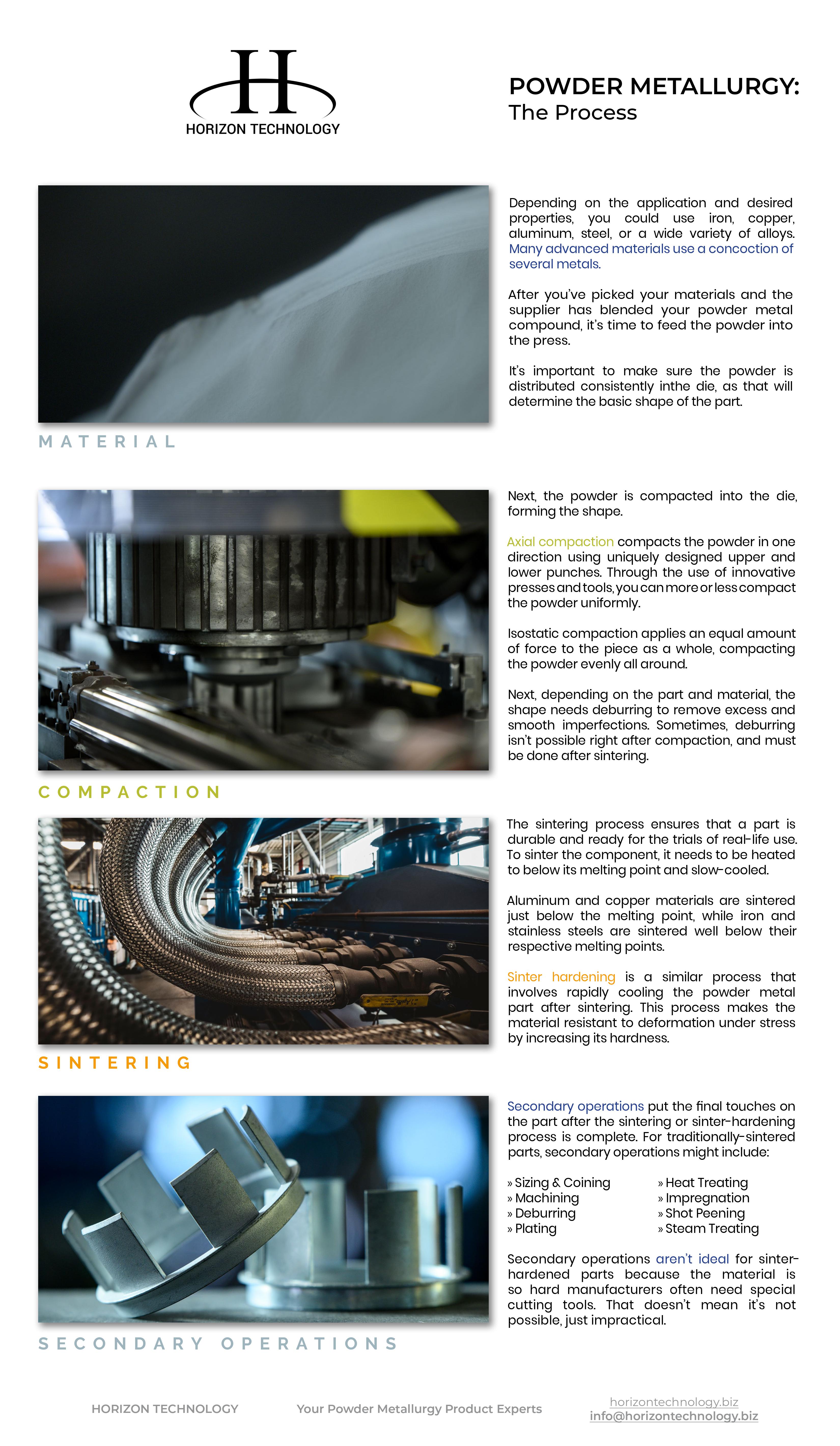The process for making a powder metal part is often overlooked in terms of how much it impacts the finished product. It’s a shame, because how powder parts are made is really quite fascinating and complex.
Take a look at this powder metallurgy process flow chart to learn more about the start-to-finish of powder metal creation.
Here’s Your Powder Metallurgy Process Flow Chart
The process of creating a successful powder metal component is a complex process that usually starts with a conversation. As you’re looking at designing a PM part, talk with your PM part supplier early in the design stage. They might have other solutions, materials, or processes that can better satisfy the needs of the application.
After this discussion, you can now have a more confident approach to the PM process:
- Choosing the metal powder blend
- Compaction
- Sintering (or heat treatment for SMC components)
- Secondary operations (if necessary)

How Metal Powder Is Made
The first step to making a powder metal part is choosing the material. Depending on the application and desired properties, you could use iron, copper, stainless steel, or a wide variety of alloys. Many advanced materials use a premixed blend of several metals. Depending on the specific requirements of the application, a custom powder metal material can be crafted to fit your needs.
Looking at the powder under magnification it may remind you of a kernel of popped popcorn. Somewhat spherical but very irregular in shape.
After you’ve picked your materials and the supplier has blended your powder metal compound, it’s time to feed the powder into the press. The volume of powder needed in the die compared to the length of the finished part or “fill ratio” is about 2:1. Meaning the column of powder in the die will be compacted by 50%. It’s also important to make sure the powder is distributed consistently throughout the die, as that will help reduce variations of density throughout the part.
The Powder Compaction Process
Next, the powder is compacted in the die, forming the shape. Not all compaction methods are the same, however. Axial compaction, as the name implies, compacts the powder in one direction using uniquely designed upper and lower punches that mirrors the surface features of your part. The use of innovative tooling and presses allow the powder to be compacted uniformly. This molded part is also known as a “green” part.
Remember the popcorn analogy of the powder, let’s carry that to the molding process. We have basically created a popcorn ball. It clearly has a defined form and looks like it is ready to go into the shipping container. However, like a popcorn ball, the mechanical bonds between each particle of powder are not strong enough and can easily be broken apart. Now we need the sintering process to form those metallurgical bonds between each particle.
Next, after molding the part it will have burrs around its edges which may need to be removed. Your parts supplier will determine if this deburring process is best done before the sintering process or after. That decision will be based on the risk of damage to the part if deburring is done prior to sintering.
After compaction, the component moves into the sintering process.
Sintering Process in Powder Metallurgy
The sintering process in powder metallurgy ensures that a part is durable and ready for the trials of real-life use. To sinter the component, it needs to be heated below its melting point in an atmosphere specifically designed for the selected material and control-cooled.
Sinter hardening is a process that can be done as part of the sintering process and involves rapidly cooling a powder metal part made from a specially designed material system after sintering. This process heat treats the part in the furnace and avoids the cost of reheating the part to perform a traditional oil quench heat treating which makes the material more resistant to deformation under stress by increasing its hardness.
Secondary Operations in Powder Metallurgy
After the sintering or sinter hardening process is complete, it’s then time to move onto secondary operations.
Machining for sinter-hardened materials is very difficult because of the hardness of the material. Some machining of sinter-hardened parts is possible, either via grinding or specifically designed cutting tools, but mass metal removal is impractical.
A common secondary operation for sinter hardened components is tempering to improve the tensile strength of the part.
But, with a conventionally-sintered part, numerous secondary options are available. These include:
- Sizing - sintering can alter the shape of a part, but repressing it can improve tolerance limits as much as 50%
- Coining - to create a raised detail on a part, a die stamps a feature upward to create a 3D effect
- Machining - to reach tighter tolerances or meet specific requirements, a piece may need grinding, turning, or milling
- Deburring - this process removes any excess from the part to ensure the well-being of its handlers and the equipment it will be used in.
- Impregnation - PM components are porous, so filling them with plastic, oil, or other materials ensures they are pressure-tight, self-lubricated, or have other potential unique characteristics
- Plating - this allows you to create a piece with a composite structure while including less expensive material on the inside. Examples of this are plating to achieve corrosion / oxidation resistance or even add a hard surface to a soft core.
- Shot peening - this process improves the part surface by preventing crack formation and creating pockets to catch lubricants on the part’s surface
- Steam treating - this process creates a thin-but-tenacious oxide layer on the part to improve corrosion resistance, pressure tightness, and hardness
- Heat treating - When parts require secondary operations after sintering, like machining, they then need to be heat-treated aftwards. All common heat treatments applied to wrought materials can be applied to PM materials.
Your Powder Metallurgy Products Experts
Need to learn more about the intricate processes behind powder metallurgy products? Our engineers are experts in their field, and can help you work toward a PM solution that balances part performance with cost-efficiency:



